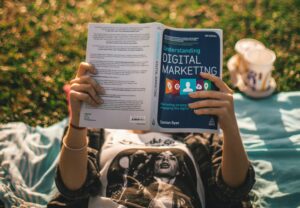The term ‘digital marketing’ covers a wide range of marketing tactics, all executed on digital platforms. Nowadays, the majority of brands use digital marketing to appeal to customers, and it has become a crucial part of marketing for businesses of all sizes.
In this article, we’ll explore the different types of digital marketing as well as its benefits, to help you decide which methods will help your business drive conversions.
Uses platforms such as Instagram, Facebook, TikTok, LinkedIn, YouTube and X to organically promote your business. Regular posting alongside efficient channel management can help to build a strong reputation for your brand, whilst the ability to make purchases directly through the app on platforms like Instagram creates an easy conversion route: according to Pymnts, over 40% of consumers use social media to find products. Social media marketing is a great way to build connections with customers and drive customer engagement, ultimately leading to higher lead and sales numbers.
A way to establish your business as a thought leader in its field, building a level of trust with audiences. This might include articles or whitepapers on specific subjects, newsletters, eBooks, audio or video content. Content marketing is less about driving sales and more about a looking at the bigger picture, cultivating your brand’s reputation to show your target audience that you are experts in your field, and increasing sales in the long run.
The process of optimising your website to appear nearer the top of a Search Engine Results Page (SERP), making potential customers more likely to click through to your site. According to Gartner, over two thirds of organic online traffic clicks come from the first five organic results on the first SERP, so SEO is hugely important in driving traffic to your website and creating leads.
To improve your SEO, you’ll need to:

Not to be confused with SEO, SEM is paid advertising that appears on SERPs. These are usually the results that appear at the very top of the page, above the organic results. These ads are PPC (Pay Per Click), so the advertiser pays every time someone clicks through to their site. Like SEO, this method of digital marketing is very effective because the majority of clicks occur on the first SERP.
Targeted advertising that your business pays for each time someone clicks on the ad. This method is more cost effective than most, as you can target a specific audience instead of churning out generic ads at a high cost, and by its nature, you only pay when someone interacts with your ad. PPC can be done on both social media and SERPs: according to Hubspot, Facebook Ads and Google Ads are the paid ad channels with the highest reported ROI.
Email campaigns can be a very effective method of digital marketing, as almost everyone has an email address, and therefore most people can be reached through this style of marketing. Statista predicts that the global email marketing market will reach $17.9 billion by 2027, growing at a compound annual growth rate of 13.3%.
Email content can be personalised to draw recipients in, and you can guide your audience towards a specific CTA through your content, whether it’s a promotional email, a newsletter, a welcome email or a follow-up email. Email marketing is also useful as it can be used at any and every stage of your marketing funnel. However, there are some things you should avoid when creating an email campaign:
Influencer marketing involves getting a social media influencer to promote your product or service in their content. Affiliate marketing is similar, but an affiliate is only paid when a purchase is made based on their content. In both cases, it’s important to pick an affiliate or influencer based on their target audience, and whether that audience aligns with yours.

One of the most convenient perks of digital marketing is that everything can be measured and attributed accurately. From the number of visits to your website, to ad clicks, to leads and conversions, digital marketing allows you to keep an eye on customer behaviour and statistics throughout the conversion process. Having a solid understanding of the exact path that customers are taking, from awareness to action, enables you to create an effective conversion funnel.
A knock-on effect of measurability is that you can maintain engagement with audiences through every stage of the conversion process and beyond. Keeping track of who is clicking where means that you can engage those people through targeted advertising or relevant emails to turn that lead into a conversion, and after that, maintain a relationship with that customer to keep them coming back for more.
Being able to target specific audiences means that you can budget your campaigns much more effectively. Instead of spending large amounts of money on adverts that aren’t guaranteed to reach the right audiences, like traditional marketing methods such as print and radio, you can ensure that you’re engaging the right people. Many digital marketing methods are very low cost, such as email campaigns and SEO, but can be high reward if carried out with care. Plus, with CPC advertising, you’re only paying when you’ve got a strong lead.
Unlike traditional marketing methods, many digital marketing avenues can be tailored to the individual consumer, making conversions much more likely. The ability to personalise content to appeal to the consumer is therefore a huge advantage of digital marketing as customers are influenced engaged throughout the marketing journey.
Remarkable are one of the world’s leading digital experience agencies. As a double Platinum Sitecore and Optimizely partner, we offer technology solutions to help brands build experiences that convert.